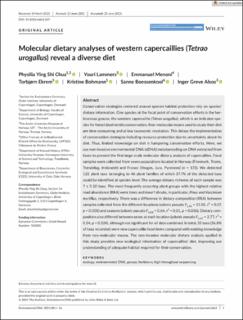| dc.description.abstract | Conservation strategies centered around species habitat protection rely on species’ dietary information. One species at the focal point of conservation efforts is the herbivorous grouse, the western capercaillie (Tetrao urogallus), which is an indicator species for forest biodiversity conservation. Non-molecular means used to study their diet are time-consuming and at low taxonomic resolution. This delays the implementation of conservation strategies including resource protection due to uncertainty about its diet. Thus, limited knowledge on diet is hampering conservation efforts. Here, we use non-invasive environmental DNA (eDNA) metabarcoding on DNA extracted from faces to present the first large-scale molecular dietary analysis of capercaillies. Facal samples were collected from seven populations located in Norway (Finnmark, Troms, Trøndelag, Innlandet) and France (Vosges, Jura, Pyrenees) (n = 172). We detected 122 plant taxa belonging to 46 plant families of which 37.7% of the detected taxa could be identified at species level. The average dietary richness of each sample was 7 ± 5 SD taxa. The most frequently occurring plant groups with the highest relative read abundance (RRA) were trees and dwarf shrubs, in particular, Pinus and Vaccinium myrtillus, respectively. There was a difference in dietary composition (RRA) between samples collected from the different locations (adonis pseudo F5,86 = 11.01, r2 = 0.17, p = 0.001) and seasons (adonis pseudo F2,03 = 0.64, r2 = 0.01, p = 0.036). Dietary composition also differed between sexes at each location (adonis pseudo F1,47 = 2.77, r2 = 0.04, p = 0.024), although not significant for all data combined. In total, 35 taxa (36.8% of taxa recorded) were new capercaillie food items compared with existing knowledge from non-molecular means. The non-invasive molecular dietary analysis applied in this study provides new ecological information of capercaillies’ diet, improving our understanding of adequate habitat required for their conservation. | en_US |

